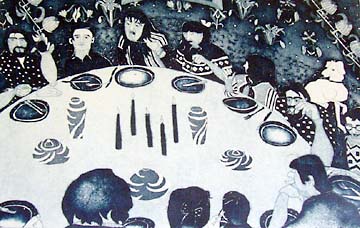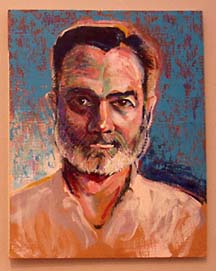|


Oct. 14, 2004
COVER
STORY | IN THE NEWS | GARDEN | THE HUM | PREVIEW | CALENDAR
Artistic
legacies
by LINDA MITCHELL
I WAS NEVER MUCH OF A HISTORY
BUFF AS A KID. THIS aversion probably had to do with the fact
that my mother adored anything smacking of bygone eras, and forced
my siblings and me to endure one historical site and ghost town
after another. She was especially fond of California's missions
She thought nothing of taking hundred-mile detours on family
vacations to examine one. "Look at these!" she'd
enthuse over fragments of lumpy pottery housed in damp adobe
remains. "Can you believe the Indians made them by hand?"
At the time, these historical
jaunts didn't inspire much more than boredom and a firm determination
to "be here now," but eventually I came to appreciate
the cultural history of my home state. Oddly enough, my interest
in the past wasn't engaged by my original firsthand visits to
historical sites and vistas, but rather by viewing these things
through the eyes and hands of early California painters.
Left, "Dinner with
the McKnights" by Brenda Tuxford. Self portrait by Reese
Bullen.
Throughout my childhood and
early adulthood, I was fortunate enough to live near cities that
were early art colonies, like Pasadena, Laguna Beach and Monterey,
places with galleries and small museums brimming with the work
of artists who had found inspiration in California's historical
treasures. After seeing paintings of missions by William Keith,
Edwin Deacon and Arthur Rider, I began to study the history of
these structures with a more appreciative eye. Similarly, cityscapes
by Wayne Thiebald and landscapes by Maynard Dixon and Edgar Payne
inspired me to travel the state, rediscovering the beauty these
artists had witnessed before me.
Artists chronicle the people,
places, things and ideas in their surrounding environment, whether
they intend to or not. Studying their work can open the door
to an awareness of our connection to our cultural past, often
compelling us to learn more. On a local level, this concept seems
timely, since over the past several months some of our art community's
most influential and inspiring creative voices have crossed over
into history.
Peter Palmquist, photographer
and internationally renowned photo historian, was killed by a
hit-and-run driver in January 2003; Reese Bullen, a multi-media
artist who established the art department at HSU died last November;
we lost Justin Schmit, a sculptor who served on the board of
the Redwood Art Association, this past May; and in August came
the stunning news that Brenda Tuxford, co-founder of The Ink
People, had suffered a fatal heart attack while visiting her
son in Amsterdam.
Although these local voices
have been silenced, their place in our cultural history survives
through the work they produced. I used to think that once an
artist was gone, their work became finite, something historians
could examine in its entirety. I have discovered that artists
live on through their work and their contributions to the community,
continuing to teach and inspire future generations infinitely.
Consider the exhibition of Reese
Bullen's work at the gallery named in his honor at HSU (through
Oct. 23). When Bullen arrived in Arcata in 1946 with his master's
degree from Stanford University, Humboldt State was a small liberal
arts college. Bullen established the art department, hiring teachers,
developing a curriculum, and expanding the program throughout
his 30-year tenure. He retired in 1976, but his influence, as
an educator and visual artist, continues to be felt today.
For me, the most compelling
pieces in the Bullen exhibit are the artist's acrylic paintings
on paper from the `80s, works that hover between reality and
complete abstraction, with crisp, complex layering of colors
and heartbreakingly eloquent brushwork. Yet equally compelling
and historically significant are examples from his time spent
educating future artists at HSU. The exhibit includes early ceramics
and watercolors, as well as photos and demonstration pieces from
his calligraphy classes and two wonderful portraits of the artist
and his wife, Dorothy, from the early `50's. These paintings
capture the couple's youth and intensity at a specific time in
our regional history.
Similarly, the etchings, paintings,
and handmade books in Brenda Tuxford's current retrospective
exhibit at A.G. Edwards in Eureka (through November) illustrate
the artist's presence during a specific era on the north coast.
Tuxford moved to Humboldt from Saskatchewan, Canada in the late
`60s, during that "back to the land" movement. She
met Libby Maynard while they were both pursuing their master's
degrees in art, and the pair founded The Ink People Center for
the Arts in 1979.
Throughout her 25 years of serving
the art community at The Ink People, Tuxford touched and inspired
many lives. Stories about her talent, generosity, wisdom, and
sense of humor abound and remain evident in the art she left
behind.
The work in Tuxford's retrospective
exhibit is almost entirely figurative and narrative, expressing
in a whimsical yet elegantly rendered manner her interpretation
of the people and environment that surrounded her while she lived
here. A prolific artist, Tuxford was constantly experimenting,
reinventing and recycling her work in a variety of media as she
sought to chronicle the time she spent among us.
And perhaps the most prolific
voice of all, in terms of local cultural history, belonged to
Peter Palmquist. A professional photographer, Palmquist was also
a prodigious collector, writer and internationally respected
authority on the history of photography in the American West.
His collection ultimately came to include more than a quarter-million
photographs and much of his archive is permanently housed at
Yale University's Beinecke Rare Book and Manuscript Library.
(See Journal cover story "A Photographer's Obsession,"
Jan. 24, 2002)
The most recent exhibition of
Palmquist's work at the Morris Graves Museum paired his photographs
with those A.W. Ericson (1848-1927), one of many local photographers
whose work Palmquist collected and wrote about. The combined
work furnished nearly a century and a half of images featuring
significant people, places and events in our county's history,
images destined to bring the past alive for generations to come.
In the literature accompanying
the Palmquist-Ericson exhibit, it was noted that Palmquist "spoke
of photographic images as collective `twigs' on our global society's
`family tree'." I'd like to extend that analogy to all visual
images. Studying these twigs can lead to an understanding of
where we've been, where we are, and what it's possible to achieve.
n
Linda Mitchell can be reached
via
COVER
STORY | IN THE NEWS | GARDEN | THE HUM | PREVIEW | CALENDAR
Comments?

© Copyright 2003, North Coast Journal,
Inc.
|